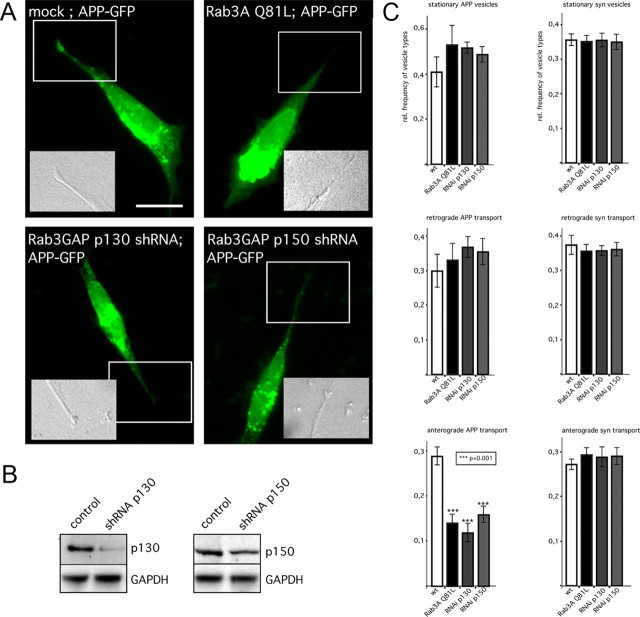Figure 4.
Rab3 GTPase activity is essential for APP fast anterograde transport. Neuroblastoma cells (SH-SY5Y) were cotransfected with APP–GFP cDNA and empty vector (mock), Rab3A Q81L cDNA, shRNA constructs directed against Rab3GAP p130, or Rab3GAP p150. A, Mock-transfected cells expressing APP–GFP displayed an accumulation of APP–GFP at the tips of neurites (box), whereas inhibition of Rab3A GTPase activity by expression of mutant Rab3A Q81L or silencing of Rab3GAP p130 or p150 caused a decrease of APP–GFP levels at the tips. Differential interference contrast images of the regions of interest/of the indicated regions (boxed) are shown as insets. Scale bar, 10 μm. B, The silencing efficiency of the human Rab3GAP p130 or Rab3GAP p150 shRNA was of ∼40–60%. Taking into account that the transfection rate with the vector-based shRNA constructs was 50–60%, the knockdown efficiency per transfected cell was estimated to be ∼70–80%. GAPDH, Glyceraldehyde-3-phosphate dehydrogenase. C, APP–GFP (left) or synaptophysin–GFP (right) fusion proteins were analyzed by time-lapse microscopy (5 frames/s) in mock-transfected neuroblastoma cells (white columns), cells coexpressing Rab3A Q81L (black columns), or cells with knockdown [RNA interference (RNAi)] of Rab3GAP p130 (dark gray columns) or Rab3GAP p150 (light gray columns). Kymographs from single cells (n = 12) were analyzed. The relative frequencies of stationary, retrogradely, or anterogradely transported APP–GFP (left) or synaptophysin–GFP (right) containing vesicles was determined. The range of velocities for synaptophysin–GFP (syn) is lower (1–5 μm/s) than the range seen with APP (1–10 μm/s). Therefore, we determined only the relative frequency of anterograde APP–GFP vesicles moving at velocities ≥4 μm. Error bars represent SEM. ***p < 0.001, t test.

